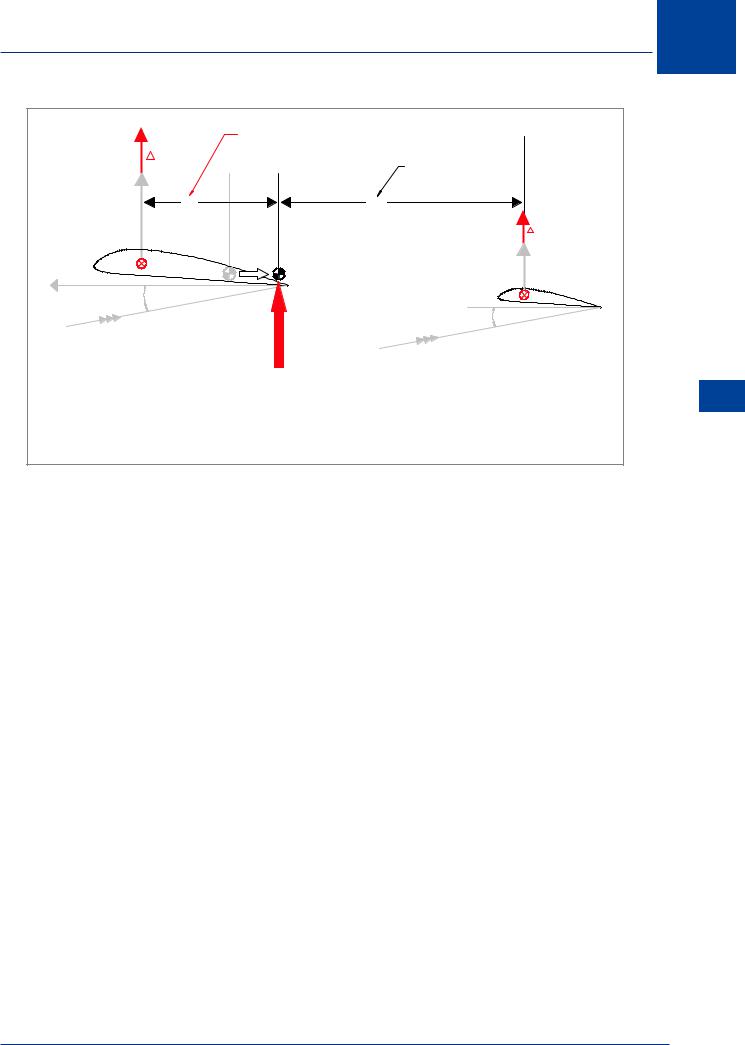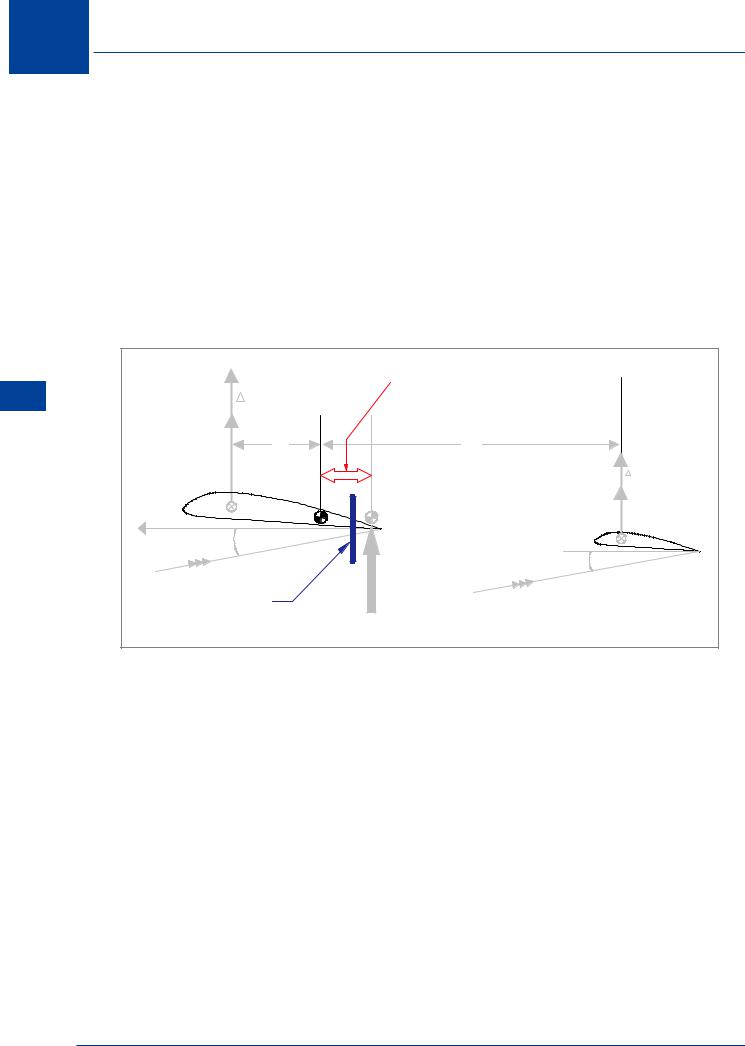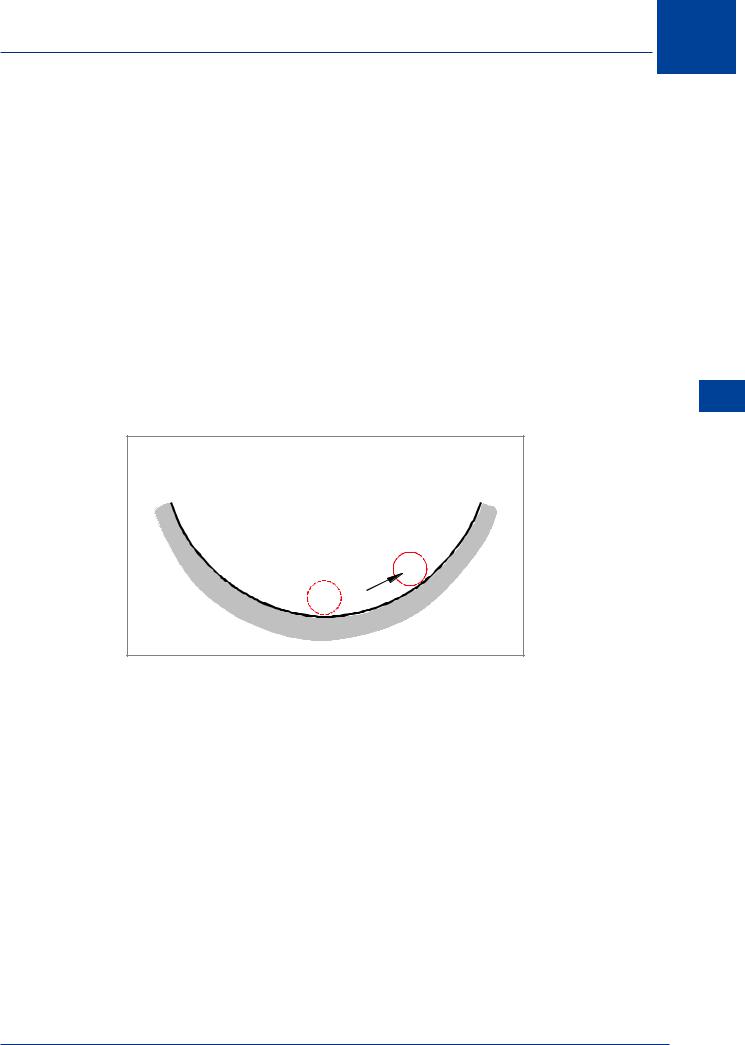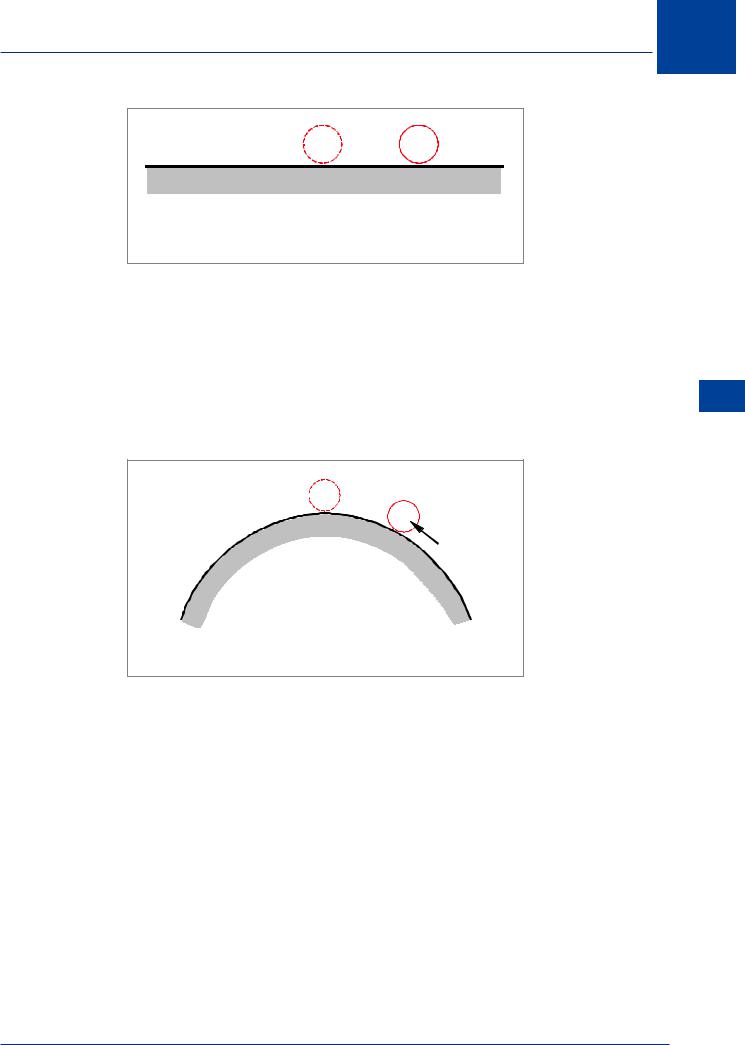
- •Textbook Series
- •Contents
- •1 Overview and Definitions
- •Overview
- •General Definitions
- •Glossary
- •List of Symbols
- •Greek Symbols
- •Others
- •Self-assessment Questions
- •Answers
- •2 The Atmosphere
- •Introduction
- •The Physical Properties of Air
- •Static Pressure
- •Temperature
- •Air Density
- •International Standard Atmosphere (ISA)
- •Dynamic Pressure
- •Key Facts
- •Measuring Dynamic Pressure
- •Relationships between Airspeeds
- •Airspeed
- •Errors and Corrections
- •V Speeds
- •Summary
- •Questions
- •Answers
- •3 Basic Aerodynamic Theory
- •The Principle of Continuity
- •Bernoulli’s Theorem
- •Streamlines and the Streamtube
- •Summary
- •Questions
- •Answers
- •4 Subsonic Airflow
- •Aerofoil Terminology
- •Basics about Airflow
- •Two Dimensional Airflow
- •Summary
- •Questions
- •Answers
- •5 Lift
- •Aerodynamic Force Coefficient
- •The Basic Lift Equation
- •Review:
- •The Lift Curve
- •Interpretation of the Lift Curve
- •Density Altitude
- •Aerofoil Section Lift Characteristics
- •Introduction to Drag Characteristics
- •Lift/Drag Ratio
- •Effect of Aircraft Weight on Minimum Flight Speed
- •Condition of the Surface
- •Flight at High Lift Conditions
- •Three Dimensional Airflow
- •Wing Terminology
- •Wing Tip Vortices
- •Wake Turbulence: (Ref: AIC P 072/2010)
- •Ground Effect
- •Conclusion
- •Summary
- •Answers from page 77
- •Answers from page 78
- •Questions
- •Answers
- •6 Drag
- •Introduction
- •Parasite Drag
- •Induced Drag
- •Methods of Reducing Induced Drag
- •Effect of Lift on Parasite Drag
- •Aeroplane Total Drag
- •The Effect of Aircraft Gross Weight on Total Drag
- •The Effect of Altitude on Total Drag
- •The Effect of Configuration on Total Drag
- •Speed Stability
- •Power Required (Introduction)
- •Summary
- •Questions
- •Annex C
- •Answers
- •7 Stalling
- •Introduction
- •Cause of the Stall
- •The Lift Curve
- •Stall Recovery
- •Aircraft Behaviour Close to the Stall
- •Use of Flight Controls Close to the Stall
- •Stall Recognition
- •Stall Speed
- •Stall Warning
- •Artificial Stall Warning Devices
- •Basic Stall Requirements (EASA and FAR)
- •Wing Design Characteristics
- •The Effect of Aerofoil Section
- •The Effect of Wing Planform
- •Key Facts 1
- •Super Stall (Deep Stall)
- •Factors that Affect Stall Speed
- •1g Stall Speed
- •Effect of Weight Change on Stall Speed
- •Composition and Resolution of Forces
- •Using Trigonometry to Resolve Forces
- •Lift Increase in a Level Turn
- •Effect of Load Factor on Stall Speed
- •Effect of High Lift Devices on Stall Speed
- •Effect of CG Position on Stall Speed
- •Effect of Landing Gear on the Stall Speed
- •Effect of Engine Power on Stall Speed
- •Effect of Mach Number (Compressibility) on Stall Speed
- •Effect of Wing Contamination on Stall Speed
- •Warning to the Pilot of Icing-induced Stalls
- •Stabilizer Stall Due to Ice
- •Effect of Heavy Rain on Stall Speed
- •Stall and Recovery Characteristics of Canards
- •Spinning
- •Primary Causes of a Spin
- •Phases of a Spin
- •The Effect of Mass and Balance on Spins
- •Spin Recovery
- •Special Phenomena of Stall
- •High Speed Buffet (Shock Stall)
- •Answers to Questions on Page 173
- •Key Facts 2
- •Questions
- •Key Facts 1 (Completed)
- •Key Facts 2 (Completed)
- •Answers
- •8 High Lift Devices
- •Purpose of High Lift Devices
- •Take-off and Landing Speeds
- •Augmentation
- •Flaps
- •Trailing Edge Flaps
- •Plain Flap
- •Split Flap
- •Slotted and Multiple Slotted Flaps
- •The Fowler Flap
- •Comparison of Trailing Edge Flaps
- •and Stalling Angle
- •Drag
- •Lift / Drag Ratio
- •Pitching Moment
- •Centre of Pressure Movement
- •Change of Downwash
- •Overall Pitch Change
- •Aircraft Attitude with Flaps Lowered
- •Leading Edge High Lift Devices
- •Leading Edge Flaps
- •Effect of Leading Edge Flaps on Lift
- •Leading Edge Slots
- •Leading Edge Slat
- •Automatic Slots
- •Disadvantages of the Slot
- •Drag and Pitching Moment of Leading Edge Devices
- •Trailing Edge Plus Leading Edge Devices
- •Sequence of Operation
- •Asymmetry of High Lift Devices
- •Flap Load Relief System
- •Choice of Flap Setting for Take-off, Climb and Landing
- •Management of High Lift Devices
- •Flap Extension Prior to Landing
- •Questions
- •Annexes
- •Answers
- •9 Airframe Contamination
- •Introduction
- •Types of Contamination
- •Effect of Frost and Ice on the Aircraft
- •Effect on Instruments
- •Effect on Controls
- •Water Contamination
- •Airframe Aging
- •Questions
- •Answers
- •10 Stability and Control
- •Introduction
- •Static Stability
- •Aeroplane Reference Axes
- •Static Longitudinal Stability
- •Neutral Point
- •Static Margin
- •Trim and Controllability
- •Key Facts 1
- •Graphic Presentation of Static Longitudinal Stability
- •Contribution of the Component Surfaces
- •Power-off Stability
- •Effect of CG Position
- •Power Effects
- •High Lift Devices
- •Control Force Stability
- •Manoeuvre Stability
- •Stick Force Per ‘g’
- •Tailoring Control Forces
- •Longitudinal Control
- •Manoeuvring Control Requirement
- •Take-off Control Requirement
- •Landing Control Requirement
- •Dynamic Stability
- •Longitudinal Dynamic Stability
- •Long Period Oscillation (Phugoid)
- •Short Period Oscillation
- •Directional Stability and Control
- •Sideslip Angle
- •Static Directional Stability
- •Contribution of the Aeroplane Components.
- •Lateral Stability and Control
- •Static Lateral Stability
- •Contribution of the Aeroplane Components
- •Lateral Dynamic Effects
- •Spiral Divergence
- •Dutch Roll
- •Pilot Induced Oscillation (PIO)
- •High Mach Numbers
- •Mach Trim
- •Key Facts 2
- •Summary
- •Questions
- •Key Facts 1 (Completed)
- •Key Facts 2 (Completed)
- •Answers
- •11 Controls
- •Introduction
- •Hinge Moments
- •Control Balancing
- •Mass Balance
- •Longitudinal Control
- •Lateral Control
- •Speed Brakes
- •Directional Control
- •Secondary Effects of Controls
- •Trimming
- •Questions
- •Answers
- •12 Flight Mechanics
- •Introduction
- •Straight Horizontal Steady Flight
- •Tailplane and Elevator
- •Balance of Forces
- •Straight Steady Climb
- •Climb Angle
- •Effect of Weight, Altitude and Temperature.
- •Power-on Descent
- •Emergency Descent
- •Glide
- •Rate of Descent in the Glide
- •Turning
- •Flight with Asymmetric Thrust
- •Summary of Minimum Control Speeds
- •Questions
- •Answers
- •13 High Speed Flight
- •Introduction
- •Speed of Sound
- •Mach Number
- •Effect on Mach Number of Climbing at a Constant IAS
- •Variation of TAS with Altitude at a Constant Mach Number
- •Influence of Temperature on Mach Number at a Constant Flight Level and IAS
- •Subdivisions of Aerodynamic Flow
- •Propagation of Pressure Waves
- •Normal Shock Waves
- •Critical Mach Number
- •Pressure Distribution at Transonic Mach Numbers
- •Properties of a Normal Shock Wave
- •Oblique Shock Waves
- •Effects of Shock Wave Formation
- •Buffet
- •Factors Which Affect the Buffet Boundaries
- •The Buffet Margin
- •Use of the Buffet Onset Chart
- •Delaying or Reducing the Effects of Compressibility
- •Aerodynamic Heating
- •Mach Angle
- •Mach Cone
- •Area (Zone) of Influence
- •Bow Wave
- •Expansion Waves
- •Sonic Bang
- •Methods of Improving Control at Transonic Speeds
- •Questions
- •Answers
- •14 Limitations
- •Operating Limit Speeds
- •Loads and Safety Factors
- •Loads on the Structure
- •Load Factor
- •Boundary
- •Design Manoeuvring Speed, V
- •Effect of Altitude on V
- •Effect of Aircraft Weight on V
- •Design Cruising Speed V
- •Design Dive Speed V
- •Negative Load Factors
- •The Negative Stall
- •Manoeuvre Boundaries
- •Operational Speed Limits
- •Gust Loads
- •Effect of a Vertical Gust on the Load Factor
- •Effect of the Gust on Stalling
- •Operational Rough-air Speed (V
- •Landing Gear Speed Limitations
- •Flap Speed Limit
- •Aeroelasticity (Aeroelastic Coupling)
- •Flutter
- •Control Surface Flutter
- •Aileron Reversal
- •Questions
- •Answers
- •15 Windshear
- •Introduction (Ref: AIC 84/2008)
- •Microburst
- •Windshear Encounter during Approach
- •Effects of Windshear
- •“Typical” Recovery from Windshear
- •Windshear Reporting
- •Visual Clues
- •Conclusions
- •Questions
- •Answers
- •16 Propellers
- •Introduction
- •Definitions
- •Aerodynamic Forces on the Propeller
- •Thrust
- •Centrifugal Twisting Moment (CTM)
- •Propeller Efficiency
- •Variable Pitch Propellers
- •Power Absorption
- •Moments and Forces Generated by a Propeller
- •Effect of Atmospheric Conditions
- •Questions
- •Answers
- •17 Revision Questions
- •Questions
- •Answers
- •Explanations to Specimen Questions
- •Specimen Examination Paper
- •Answers to Specimen Exam Paper
- •Explanations to Specimen Exam Paper
- •18 Index

Stability and Control 10
|
L |
INCREASED |
|
|
DECREASED |
||
L |
|
||
x |
y |
||
|
|||
|
|
Lt |
|
|
AC |
Lt |
|
|
|
AC |
|
|
|
NEUTRAL POINT |
|
|
|
POSITION OF CG WHEN |
|
|
|
TAIL MOMENT AND |
|
|
|
WING MOMENT |
|
|
|
ARE EQUAL |
Figure 10.9 Neutral point
Neutral Point
If you consider the CG moving rearwards from a position of static longitudinal stability:
•the tail arm ‘y’ will decrease and the wing arm ‘x’ will increase; consequently,
•the (negative) tail moment will decrease and the (positive) wing moment will increase,
Figure 10.9.
Eventually the CG will reach a position at which the tail moment is the same as the wing moment. If a vertical gust displaces the aircraft nose-up, the sum of the moments will be zero and there will be no angular acceleration about the CG to return the aircraft towards its original position of equilibrium.
Because there is no resultant moment, either nose-up or nose-down, the aircraft will remain in its new position of equilibrium; the aircraft will have neutral static longitudinal stability. See page 245.
The position of the CG when the sum of the changes in the tail moment and wing moment caused by the gust is zero is known as the neutral point, Figure 10.9.
Stability and Control 10
249

10 Stability and Control
Static Margin
Control and Stability 10
We have established that with the CG on the neutral point the aircraft will have neutral static longitudinal stability, i.e. the sum changes in the wing moment and the tail moment caused by a disturbance is zero.
If the CG is positioned just forward of the neutral point, the tail moment will be slightly greater than the wing moment (arm ‘y’ increased and arm ‘x’ decreased). A vertical gust which increases the angle of attack will generate a small nose-down angular acceleration about the CG, which will gently return the aircraft towards its original position of trim (equilibrium).
The further forward the CG, the greater the nose-down angular acceleration about the CG - the greater the degree of static longitudinal stability.
|
|
STATIC MARGIN |
|
L |
|
L |
x |
y |
|
||
|
|
Lt |
AC |
L t |
|
AC |
AFT CG |
|
LIMIT |
NEUTRAL POINT |
|
Figure 10.10 Static margin & aft CG limit
The neutral point is an important point of reference in the study of static longitudinal stability. In practice, the CG will never be allowed to move so far aft that it reached the neutral point. The aircraft would be much too sensitive to the controls.
It has been stated that the further forward the CG is from the neutral point, the greater the static longitudinal stability. The distance the CG is forward of the neutral point will give a measure of the static longitudinal stability; this distance is called the static margin, Figure 10.10. The greater the static margin, the greater the static longitudinal stability.
A certain amount of static longitudinal stability is always required, so the aft CG limit will be positioned some distance forward of the neutral point. The distance between the neutral point and the aft CG limit gives the required minimum static stability margin.
250

Stability and Control
Trim and Controllability
An aircraft is said to be trimmed (in trim) if all moments in pitch, roll, and yaw are equal to zero. The establishment of trim (equilibrium) at various conditions of flight may be accomplished by:
•pilot effort
•trim tabs
•variable incidence trimming tailplane
•moving fuel between the wing tanks and an aft located trim tank, or
•bias of a surface actuator (powered flying controls)
The term controllability refers to the ability of the aircraft to respond to control surface displacement and achieve the desired condition of flight. Adequate controllability must be available to perform take-off and landing and accomplish the various manoeuvres in flight.
A contradiction exists between stability and controllability. A high degree of stability gives reduced controllability. The relationship between static stability and controllability is demonstrated by the following four illustrations.
POSITIVE STATIC STABILITY |
Figure 10.11
Degrees of static stability are illustrated by a ball placed on various surfaces. Positive static stability is shown by the ball in a trough, Figure 10.11; if the ball is displaced from equilibrium at the bottom of the trough, there is an initial tendency to return to equilibrium. If it is desired to “control” the ball and maintain it in the displaced position, a force must be supplied in the direction of displacement to balance the inherent tendency to return to equilibrium.
This same stable tendency in an aircraft resists displacement from trim equally, whether by pilot effort on the controls (stick force) or atmospheric disturbance.
10
Stability and Control 10
251

10 Stability and Control
Control and Stability 10
INCREASED POSITIVE
STATIC STABILITY
Figure 10.12
The effect of increased static stability (forward CG movement) on controllability is illustrated by the ball in a steeper trough, Figure 10.12. A greater force is required to “control” the ball to the same position of displacement when the static stability is increased. In this manner, a large degree of static stability tends to make the aircraft less controllable. It is necessary to achieve the proper proportion between static stability and controllability during the design of an aircraft because too much static stability (forward CG position) reduces controllability. The forward CG limit is set to ensure minimum controllability, Figure 10.13.
|
STATIC MARGIN |
|
|
L |
|
L |
x |
y |
|
||
|
|
Lt |
AC |
|
L t |
|
|
AC |
FWD CG |
|
|
LIMIT |
NEUTRAL POINT |
|
HIGH |
|
|
|
|
|
STICK |
|
|
FORCE |
AFT CG |
|
|
LIMIT |
|
|
LOW |
|
|
STICK |
|
|
FORCE |
|
Figure 10.13
252

Stability and Control 10
NEUTRAL STATIC STABILITY |
Figure 10.14
The effect of reduced static stability on controllability is shown by the ball on a flat surface, Figure 10.14. If neutral static stability exists (CG on the neutral point), the ball may be displaced from equilibrium and there is no tendency to return. A new point of equilibrium is obtained and no force is required to maintain the displacement. As static stability approaches zero, controllability increases to infinity and the only resistance to displacement is a resistance to the motion of displacement, aerodynamic damping. For this reason, decreased static stability (aft CG movement) increases controllability. If the stability of the aircraft is too low, control deflections may create exaggerated displacements of the aircraft.
NEGATIVE STATIC STABILITY
Figure 10.15
The effect of static instability on controllability (CG aft of the neutral point) is shown in Figure 10.15 by the ball on a hill. If the ball is displaced from equilibrium at the top of the hill, the initial tendency is for the ball to continue in the displaced direction. In order to “control” the ball at this position of displacement, a force must be applied opposite to the direction of displacement.
This effect would be apparent during flight by an unstable “feel” to the aircraft. If the controls were deflected to increase the angle of attack, the aircraft would need to be ‘held’ at the higher angle of attack by a push force to keep the aircraft from continuing in the nose-up direction. The pilot would be supplying the stability by his attempt to maintain the equilibrium; this is totally unacceptable!
Stability and Control 10
253
